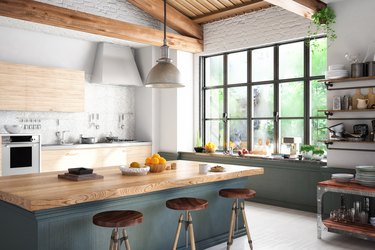
In This Article
First, there was plywood, and then came oriented strand board (OSB), a less pretty and less expensive — but arguably more stable — substitute. It was patented under the name "waferboard" in 1965, and it quickly claimed a major share of the new construction market, being used extensively for sheathing, roof decking and subfloors.
There's absolutely no problem laying a laminate floor over OSB, provided you take all the moisture-preventative steps you would take for a plywood subfloor. From a distance, OSB flooring may look a little rough and uneven, but when you get closer and feel the surface, you realize that's just an optical illusion. OSB is nearly as smooth as plywood, and once it's covered by laminate flooring, you'll never know it's there.
Video of the Day
Video of the Day
Using OSB for Flooring
OSB comes in plywood-sized sheets that are typically 4 feet wide and either 8, 9 or 10 feet long, with thickness ranging from 3/8 inch to 1 1/8 inches. In metric terms, sheets are typically 1220 x 2440 mm and have thickness from 9.5 to 28.5 mm. The minimum subfloor thickness is approximately 3/4 inches, so the minimum thickness of OSB board you will need for laminate flooring is 23/32 inches, or 18 mm.
An OSB sheet has a finely corrugated, unfinished side and a smooth side that is often coated with a clear finish. The smooth, finished side goes up when you install OSB as a subfloor. If you lay the sheet the other way, it doesn't provide proper moisture protection, and moisture protection is everything when it comes to laminate flooring.
OSB sheets should be butted together and staggered, so that end joints do not form continuous lines. This is done for stability as well as moisture control. You can screw or nail the sheets to the floor joists, but screws are preferred because they don't back out. Sink all fasteners at least 16th of an inch below the OSB surface level to prevent damage to the laminate flooring.
How Moisture Affects OSB Flooring
When it comes to moisture susceptibility, OSB performs even better than plywood. Instead of alternating thin layers that can delaminate when they get wet, OSB consists of criss-crossing chips that are highly resistant to separation. An OSB board absorbs moisture less readily than plywood, and the main problem with an OSB subfloor getting wet is that the edges of the individual sheets can swell. This swelling, although undesirable and to be avoided, is virtually unnoticeable under a laminate floor unless it is very pronounced.
It's just as important to lay a moisture barrier over OSB before installing laminate as it is to lay one over plywood. The moisture barrier should ideally have some foam material to make it soft and provide a cushion for people walking on the floor. Tape the seams of the underlayment to prevent moisture from affecting the laminate material.
Choosing OSB Over Plywood for a Laminate Subfloor
The choice between plywood and OSB is largely a matter of personal preference. Under normal circumstances, both perform equally well, but two factors may make help you make up your mind.
The first is that OSB is a greener product. It's constructed from wood chips, which are often waste from logging and milling operations. The second is price. A standard sheet of plywood suitable for a subfloor costs about $4 more than a comparable sheet of OSB at the Home Depot. You'll end up paying less for an OSB subfloor, you'll reduce your carbon footprint, and once the laminate floor is installed, you'll get the same quality of floor as you would if you used plywood.